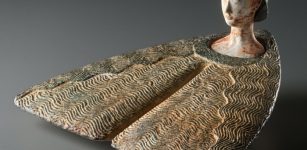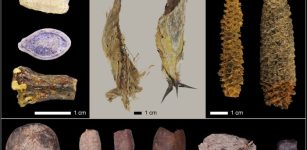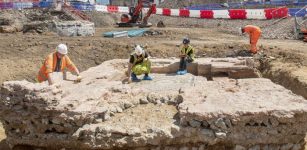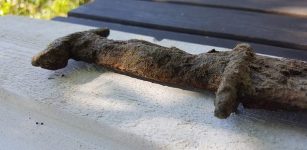Mystery Of Ancient Beehive Tombs Around The World
A. Sutherland - AncientPages.com - Strange ancient domed structures, commonly called “beehive tombs,” also known as Tholos tombs, have been found in many places around the world. What is odd about these ancient structures is that they are referred to as tombs, and yet no burial remains have been found inside them.
The most impressive beehive structure is perhaps the tomb or treasury of Atreus, sometimes called the Tomb of Clytemnestra in Mycenae, Greece. It was built around 1350 to 1250 BC. and it is the only surviving architectural structure of the Mycenaean civilization.
Entrance to the Treasury of Atreus. Credit: Adobe Stock - Karl Allen Lugmayer
The diameter of the tomb is almost 50 feet (15 meters). The enormous monolithic lintel of the doorway weighs 120 tons and is 29.5 feet (9 meters) long, 16.5 feet (5 meters) deep, and 3 feet (0.9 meters) high. It is surmounted by a relieving triangle decorated with relief plaques. It is said to have been the burial place of the king named Atreus or his son Agamemnon; interestingly, no funerary remains were ever found in it. Still, it remains one of the most impressive burial structures in Greece and was the tallest and widest dome in the world for over one thousand years until the construction of the Temple of Mercury in Baiae.
Not far from the ancient Thracian capital, Seuthopolis, in Bulgaria, we come across the famous brick beehive tomb of Kazanlak. Situated within a necropolis, the tomb is composed of a narrow corridor and a vaulted burial chamber decorated with murals of ritual funeral feasts. The tomb dates back to the fourth century B.C.
In Oman, ancient beehive tombs date to between 3500 and 2500 B.C. No burial remains have ever been retrieved from these “tombs,” though there seems no other purpose for the buildings. They have only superficial similarities with the Aegean tombs (circular shape) as they are built entirely above ground and do not share the same tripartite structure—the entrances are usually an undifferentiated part of the circular walling of the tomb.
Beehive tombs in Oman. Credit: Adobe Stock - Kylie
In Sudan, there are 17th-century beehive-like structures called Qubbas, or Koubbas, made of mud brick.
Many beehive-like stone structures were also once present in the eastern United States, presumably made by Native Americans. Over a century ago, archaeologists from the Smithsonian Institute found enigmatic cemeteries filled with beehive-shaped stone tombs in Caldwell County, North Carolina, Sullivan County, Tennessee, and Licking County, Ohio. Curiously, although broken pottery was found at these locations, human remains were not.
In the Lake Titicaca region of Peru there are many ancient sites where ancient structures called Chullpa towers have been discovered.
Sillustani Tombs – High Plains, Peru are set on a hill above Lake Umayo and were used as graves for Colla nobility. Credit: Adobe Stock - klublu
The Chullpas are wide at the top and taper to a narrower diameter at the bottom, like a funnel. It has been suggested that these enigmatic towers were probably used as grain storage silos, with the small doors being ideally suited for protecting the crop. Another scientific opinion is that the towers were burial chambers.
Many historians maintain that beehive tombs required considerable effort to construct and thus were only available to powerful leaders. It is also often stated that these ancient structures originated in ancient Greece and are a monumental Late Bronze Age development of either the Mycenaean chamber tombs or tumulus burials dating to the Middle Bronze Age. However, the origins and development of the Beehive tombs are disputed since it is clear it is a common phenomenon in various parts of the world.
Yet, the real mystery lies in the fact that these "tombs" lack human remains.
Updated on February 15, 2024
Written by – A. Sutherland AncientPages.com Staff Writer
Copyright © AncientPages.com All rights reserved. This material may not be published, broadcast, rewritten or redistributed in whole or part without the express written permission of AncientPages.com
Expand for references
More From Ancient Pages
-
 Monstrous Nomoli Figures Left By Unknown Culture That Vanished Long Ago
Artifacts | Mar 13, 2023
Monstrous Nomoli Figures Left By Unknown Culture That Vanished Long Ago
Artifacts | Mar 13, 2023 -
 Strange Flat Idol Sculpture From Bactria Remains Unexplained
Artifacts | Sep 26, 2019
Strange Flat Idol Sculpture From Bactria Remains Unexplained
Artifacts | Sep 26, 2019 -
 Breakthrough! Evidence Of Previously Unknown Prehistoric Humans Who Lived In Europe More Than 1.1 Million Years Ago!
Evolution | Mar 13, 2025
Breakthrough! Evidence Of Previously Unknown Prehistoric Humans Who Lived In Europe More Than 1.1 Million Years Ago!
Evolution | Mar 13, 2025 -
 El Gigante Offers Lessons In Sustainability, Evolution And Human Adaptation, Courtesy Of The Holocene
Archaeology | Jun 29, 2023
El Gigante Offers Lessons In Sustainability, Evolution And Human Adaptation, Courtesy Of The Holocene
Archaeology | Jun 29, 2023 -
 ‘Incredibly Rare’ Roman Tomb Unearthed Near London Bridge Station
Archaeology | Jun 13, 2023
‘Incredibly Rare’ Roman Tomb Unearthed Near London Bridge Station
Archaeology | Jun 13, 2023 -
 Who Was King Menes? Mystery Of This Legendary Ruler May Go Back 20,000 Years
Ancient Mysteries | May 1, 2017
Who Was King Menes? Mystery Of This Legendary Ruler May Go Back 20,000 Years
Ancient Mysteries | May 1, 2017 -
 Massive Bronze-Age Settlement Discovered Underwater in Greece
News | Sep 1, 2015
Massive Bronze-Age Settlement Discovered Underwater in Greece
News | Sep 1, 2015 -
 How Did A Rare 2,000-Year-Old Gem Seal Depicting God Apollo End Up In The City Of David?
Archaeology | Nov 5, 2020
How Did A Rare 2,000-Year-Old Gem Seal Depicting God Apollo End Up In The City Of David?
Archaeology | Nov 5, 2020 -
 Mysterious Advanced Underground Civilization And A Secret Society – Dangerous Knowledge And Verdict – Part 3
Ancient Mysteries | Apr 24, 2018
Mysterious Advanced Underground Civilization And A Secret Society – Dangerous Knowledge And Verdict – Part 3
Ancient Mysteries | Apr 24, 2018 -
 When Science, Spirituality and Magic Meet – Re-Discovering Old Ancient Knowledge
Featured Stories | Feb 18, 2020
When Science, Spirituality and Magic Meet – Re-Discovering Old Ancient Knowledge
Featured Stories | Feb 18, 2020 -
 On This Day In History: Great English Dramatist And Poet William Shakespeare, Was Probably Born – On Apr 23, 1564
News | Apr 23, 2016
On This Day In History: Great English Dramatist And Poet William Shakespeare, Was Probably Born – On Apr 23, 1564
News | Apr 23, 2016 -
 Evidence Of Increased Violence When The First Mesopotamian Cities Were Built
Archaeology | Oct 10, 2023
Evidence Of Increased Violence When The First Mesopotamian Cities Were Built
Archaeology | Oct 10, 2023 -
 Viking Era Sword Discovered By Young Girl
Archaeology | Oct 5, 2018
Viking Era Sword Discovered By Young Girl
Archaeology | Oct 5, 2018 -
 Yungang Grottoes: Marvellous Example Of Ancient Buddhist Rock-Cut Architecture
Featured Stories | Sep 15, 2015
Yungang Grottoes: Marvellous Example Of Ancient Buddhist Rock-Cut Architecture
Featured Stories | Sep 15, 2015 -
 Mysterious Manuscript 512 Reveals Lost Ancient City Hidden In The Amazon Jungle
Ancient Mysteries | Jan 28, 2018
Mysterious Manuscript 512 Reveals Lost Ancient City Hidden In The Amazon Jungle
Ancient Mysteries | Jan 28, 2018 -
 Seppuku: Ancient Suicide Ritual That Guaranteed Honorable Death Instead For Life In Shame
Ancient Traditions And Customs | Mar 8, 2018
Seppuku: Ancient Suicide Ritual That Guaranteed Honorable Death Instead For Life In Shame
Ancient Traditions And Customs | Mar 8, 2018 -
 Ancient Road Used By The Teutonic Knights Discovered In A Lake In Poland
Archaeology | Nov 8, 2021
Ancient Road Used By The Teutonic Knights Discovered In A Lake In Poland
Archaeology | Nov 8, 2021 -
 Secrets Of The Lost Tomb X – Mysterious Manuscripts And Strange Engravings – Part 1
Ancient Mysteries | Apr 9, 2019
Secrets Of The Lost Tomb X – Mysterious Manuscripts And Strange Engravings – Part 1
Ancient Mysteries | Apr 9, 2019 -
 Pharos Of Alexandria – One Of The First Lighthouses In The Ancient World
Featured Stories | Sep 1, 2015
Pharos Of Alexandria – One Of The First Lighthouses In The Ancient World
Featured Stories | Sep 1, 2015 -
 Underwater Stone Age Village Habonim North Found Off Israel’s Carmel Coast Thrived During Climate Change
Archaeology | Aug 1, 2024
Underwater Stone Age Village Habonim North Found Off Israel’s Carmel Coast Thrived During Climate Change
Archaeology | Aug 1, 2024



